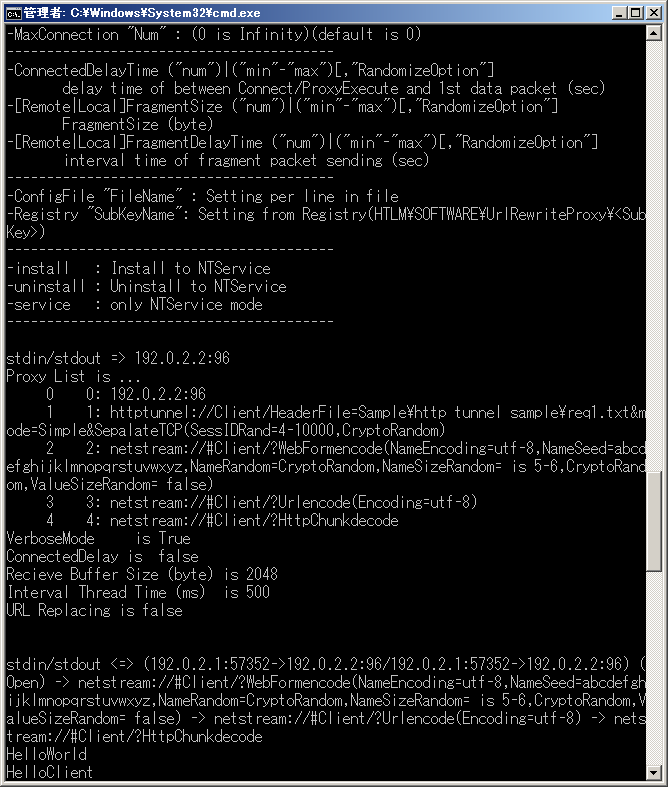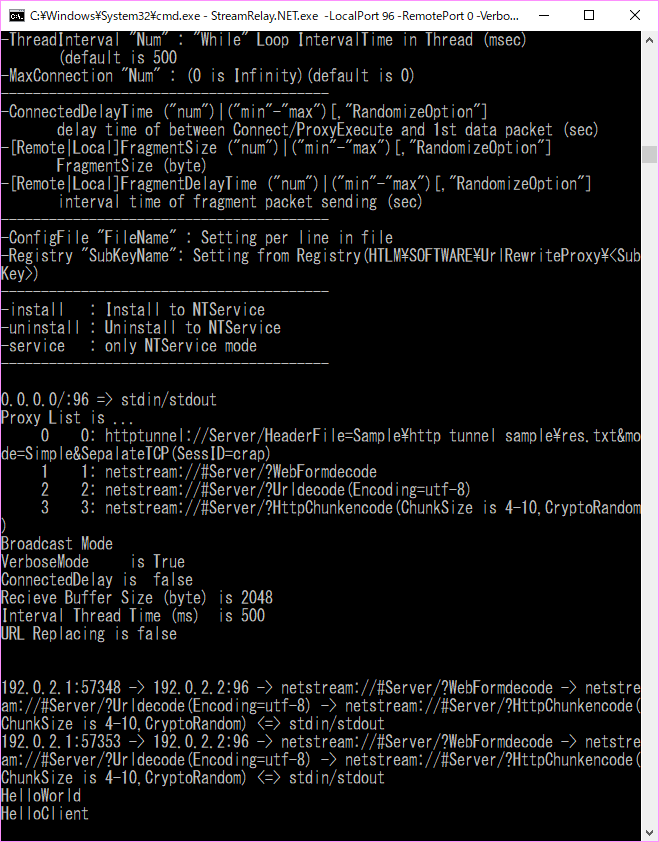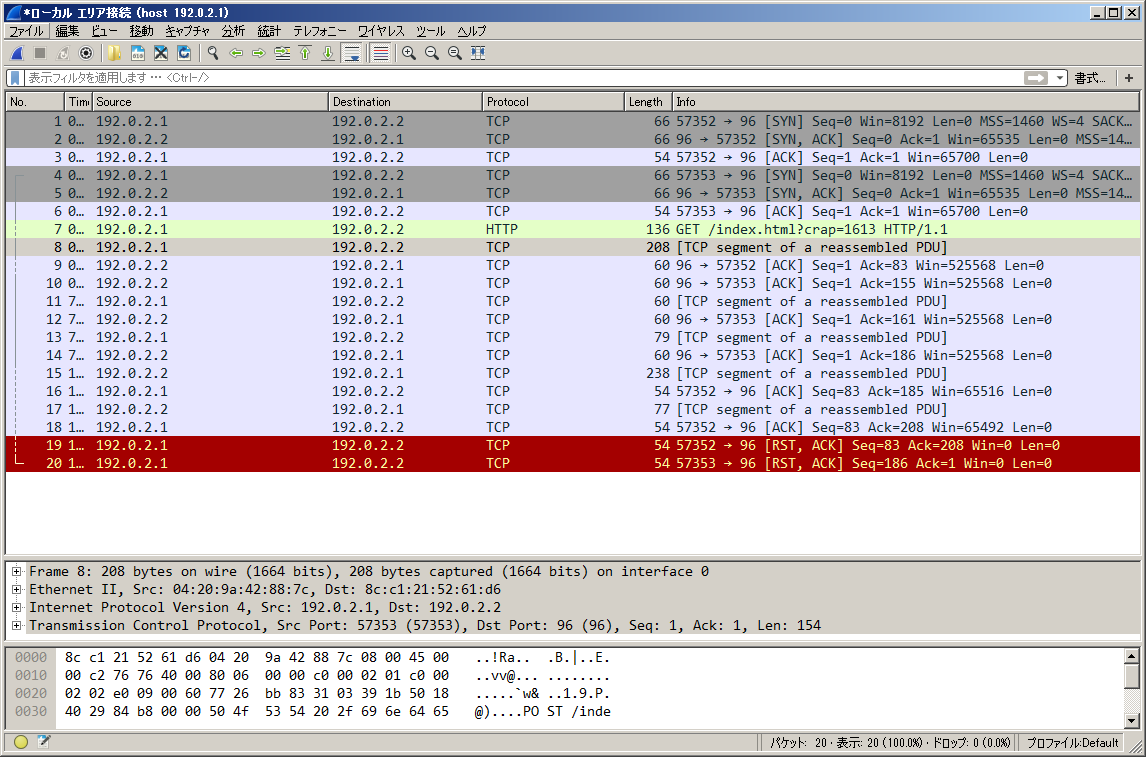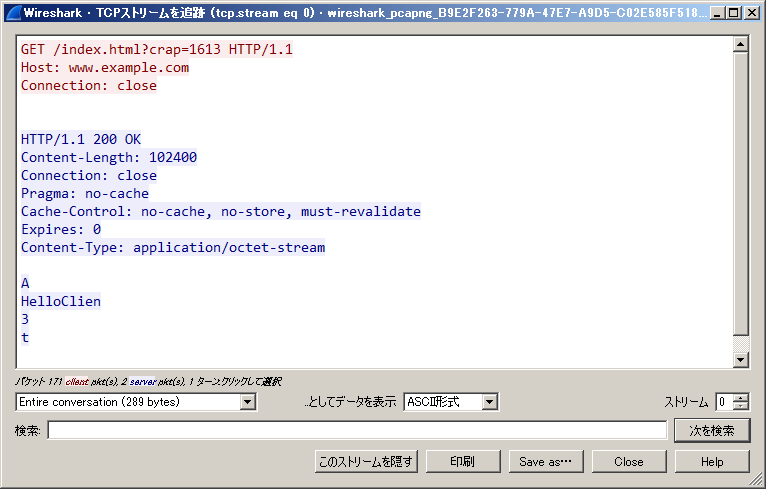httptunnel というツールがある。
その代替となるような機能をStreamRelay.NET.exeは有している
httptunnel のクライアントの代替
htc.exe --no-daemon --forward-port 95 192.0.2.1:96
⇔
StreamRelay.NET.exe -LocalPort 95 -RemoteHost 192.0.2.1 -RemotePort 96 -RemoteProxy httptunnel:///?mode=GNU^&HttpHeaderFileName=req.txt^&SeparateTCP
tcp/95 で待機して、192.0.2.1:96 の httptunnel サーバへつなげる。
その際に、HTTPリクエストのヘッダとして、「req.txt」というファイルをテンプレートとして用いる。
という意味。
テンプレートのサンプルは「Sample\http tunnel sample」にあるので、参照して欲しい。
テンプレートのポイントは「%method%」というマジックワードで、リクエスト方向には「POST」、レスポンス方向には「GET」に置き換わる
この場合、セッションIDは固定値(テンプレートファイルに記述された値で固定)となる。
httptunnel のクライアントの代替(動的セッションID)
htc.exe --no-daemon --forward-port 95 192.0.2.1:96
⇔
StreamRelay.NET.exe -VerboseMode -LocalPort 95 -RemoteHost 192.0.2.1 -RemotePort 96 -RemoteProxy httptunnel:///?mode=GNU^&HttpHeaderFileName=req1.txt^&SeparateTCP^&SessionID=4-20000%2cCryptoRandom
テンプレート中の「%sessid%」が「SessionID」で指定した乱数により(この場合は、CryptoRandomアルゴリズムで 4~20000の間で変動)、都度変更される
httptunnel のサーバの代替
hts.exe --no-daemon --forward-port 192.0.2.2:97 96
⇔
StreamRelay.NET.exe -VerboseMode -LocalPort 96 -RemoteHost 192.0.2.2 -RemotePort 97 -LocalProxy httptunnel:///?mode=GNU^&HttpHeaderFileName=res.txt^&SeparateTCP^&SessionID=crap
tcp/96 で httptunnel サーバとして待機、192.0.2.2:97 へ転送する。
その際に、HTTPレスポンスのヘッダとして、「res.txt」というファイルをテンプレートとして用いる。
という意味。
また、セッションIDの変数名として「crap」ですよ。
httptunnel より偽装度を高める(独自プロトコル)
httptunnel では、リクエスト方向には、POST メソッドを使った HTTPリクエストのボディ。レスポンス方向は、GETメソッドの応答としてのHTTPレスポンスのボディ。
と2本のTCP接続を用いているが、リクエスト方向のボディは独自フォーマットとなっていて、あまり偽装度は高くない。
という事で、リクエスト方向に、WebPostと同じような加工を行わせて、より隠蔽度を高めるコマンドが以下となる。
WebPostのような加工として、データを、「名前1=値1&名前2=値2...」の値の部分に埋め込んでいく(名前は適当なランダムな文字)
クライアント側
StreamRelay.NET.exe -LocalPort 95 -RemotePort 96 -RemoteHost 192.0.2.1 -RemoteProxy httptunnel:///?SeparateTCP^&mode=simple^&HttpHeaderFileName=req1.txt^&SessionID=4-10000%2cCryptoRandom -RemoteProxy netstream:///?WebFormEncode -RemoteProxy netstream:///?UrlEncode
サーバ側
StreamRelay.NET.exe -LocalPort 96 -RemoteHost 192.0.2.2 -RemotePort 97 -Verbose -LocalProxy httptunnel:///?SeparateTCP^&mode=Simple^&HttpHeaderFileName=res.txt^&SessionID=crap -LocalProxy netstream:///?WebFormDecode -LocalProxy netstream:///?UrlDecode
このクライアントとサーバ間のリクエスト方向は、
データを
- URLエンコード
- WebFormフォーマットに偽装する
という事で、より偽装度を高められる
「WebFormEncode」には
- 名前に使う文字の一覧
- 名前の文字数
- 一つの値の文字数
などをランダムに指定する事ができるよ。「[最小値]-[最大値],[アルゴリズム名]」みたいな感じでね。
httptunnel より偽装度を高める(独自プロトコル2)
レスポンス方向も、httpchunk 符号化すれば、より偽装度が高くなる
オプションは、netstream スキームの「HttpChunkdecode/HttpChunkencode」です。
WebForm 符号化とか HttpChunk 符号化とか
符号化コマンドとしての StreamRelay.NET.exe を参照
具体例
クライアント側
StreamRelay.NET.exe -LocalPort 0 -RemotePort 96 -RemoteHost 192.0.2.2 -RemoteProxy "httptunnel:///?SeparateTCP&mode=simple&HttpHeaderFileName=Sample\http tunnel sample\req1.txt&SessionID=4-10000%2cCryptoRandom" -RemoteProxy netstream:///?WebFormEncode=name%3d4-6%2cCryptoRandom%26Value%3d5-6%2cCryptoRandom%26CharRandom%3dCryptoRandom%26CharList%3dabcdefghijklmnopqrstuvwxyz -RemoteProxy netstream:///?UrlEncode -verbose -remoteproxy netstream:///?HttpChunkdecode
オプションが長い場合は、設定ファイルから読み込む「-ConfigFile」オプションが便利だ。
(cmd.exeのエスケープ処理とか気にしなくてよいのもメリットかと思う)
サーバ側
StreamRelay.NET.exe -LocalPort 96 -RemotePort 0 -Verbose -LocalProxy "httptunnel:///?SeparateTCP&mode=Simple&HttpHeaderFileName=Sample\http tunnel sample\res.txt&SessionID=crap" -LocalProxy netstream:///?WebFormDecode -LocalProxy netstream:///?UrlDecode -localproxy netstream:///?HttpChunkencode=4-10%2cCryptoRandom
ともにコンソール入出力を相手にして、
- サーバは 192.0.2.2:96 で待機
- クライアントとサーバ間で HttpTunnel の 分割TCP で接続
- リクエストメッセージのヘッダとなるのは、Sample\http tunnel sample\req1.txt
- レスポンスメッセージのヘッダとなるのは、Sample\http tunnel sample\res.txt
- セッションIDは「crap」
- セッションIDは「4-10000」アルゴリズムは「CryptoRandom」
- リクエストメッセージにはURLエンコードを実施後に、WebFormエンコードを実施
- WebFormエンコードの名前に使う文字種は「abcdefghijklmnopqrstuvwxyz」
- WebFormエンコードの名前の長さは「4-6」アルゴリズムは「CryptoRandom」
- WebFormエンコードの値の長さは「5-6」アルゴリズムは「CryptoRandom」
- WebFormエンコードの名前の文字種のランダムアルゴリズムは「CryptoRandom」
- レスポンスメッセージはHttpChunkエンコードを実施
- HttpChunkの長さは「4-10」アルゴリズムは「CryptoRandom」
という内容で通信をしている。
HttpTunnel は上りと下りで2本のTCPストリームを使うので、
どうだろう。GnuHttpTunnelより隠蔽度は高くなっていると思うけど。
(res.txtが、Content-Lengthとか付いているので、よりHttpChunk時のヘッダっぽいHTTPレスポンス・ヘッダのテンプレートを使うとさらによいでしょう)
(近いうちに res1.txtとかで同梱しておく予定)
さらに、暗号系のフィルタも加えれば、そもそも解析できなくする事は可能。
「zebedee のような vpn の代替としての StreamRelay.NET.exe」を参照




